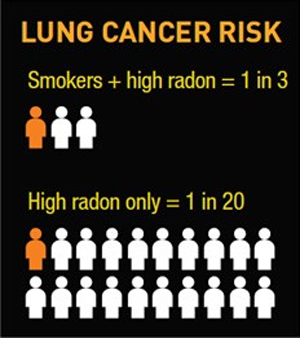You can’t see radon, but it is easy to detect with a simple, inexpensive test. You may choose to test your home yourself or you can hire a qualified radon testing professional. Either approach takes only a small amount of effort.
Do-it-yourself tests
There are several types of devices to test your home, but one device commonly used by homeowners is the “alpha track” radon detector, available from your local hardware store, and some online retailers. Follow all of the instructions that come with your test kit. The detector must be mailed back to a laboratory for analysis at the end of the test.
Hiring a qualified professional
Contact a Canadian National Radon Proficiency Program (C-NRPP) certified radon measurement professional in your area. The C-NRPP certified professional will advise you on what type of radon detection device best meets your current needs.
How long to test for radon
Long-term tests, lasting anywhere from 91 days to 365 days, will give you a dependable reading of your actual radon risk at home. If choosing to perform a long-term test less than the maximum of 365 days period, be sure that the test period includes the winter season, when the homes heating system is being used.
Short-term tests are useful at quickly assessing the possible long-term exposure level, and to confirm the successful installation of radon mitigation systems, when long-term testing has confirmed that radon was a problem. Depending on the device, it may be used anywhere from 2 to 90 days. Because radon levels can change from day to day, and season to season, a short-term result is less able to assess your long term, year-round average radon risk. If you are using a short-term test device, Hamilton Public Health recommends testing for a minimum of 7 days, and keeping outside windows and doors closed as much as possible during the test period. For periods shorter than 7 days, it is recommended that you consult a C-NRPP certified professional to conduct the test.
Where to test for radon
The test device should be placed in the lowest lived-in level of the home, where people typically spend 4 or more hours per day. For example, in an unfinished basement, with only a laundry room and storage area, the device should be placed on the first floor of the home. Lived-in areas of the home, such as family rooms, dens and bedrooms are suitable locations. Avoid placing the device in a kitchen or bathroom. Also, be sure to follow all of the instructions that come with your test kit (i.e. any specified distance away from the floor, ceiling, exterior walls, doors and windows, vents, or sources of heat).
What your test results mean
Lower radon levels are better. If you have conducted a short-term test (less than 91 days), you should still consider following up with a long-term test, before concluding that you do or do not have a radon problem in your home.
- For long-term test results over 100 Bq/m3, you may consider taking action to lower your radon level.
- Above 200 Bq/m3, it is recommended that you lower your radon levels within 2 years.
- Over 600 Bq/m3, it is recommended that you fix the problem with 1 year.
For help interpreting your test results, you can contact Hamilton Public Health Services at 905-546-2489.



